united airlines
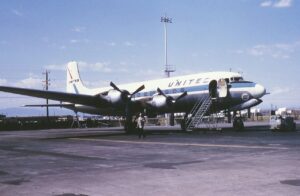 United Air Lines Flight 629, registration N37559, was a Douglas DC-6B aircraft also known as “Mainliner Denver.” The regular route for the flight was from New York City to Portland, Oregon, and then on to Seattle, Washington. This flight made one stop in Chicago and one in Denver. On November 1, 1955, United Airlines Flight 629 left New York City’s La Guardia Airport. It made a scheduled stop in Chicago before continuing to Denver’s Stapleton Airfield and landed at 6:11pm, eleven minutes late. Other than being eleven minutes late, the flight had been completely routine. The plane was refueled with 3,400 US gallons of fuel and had a crew replacement in Denver. Captain Lee Hall, aged 41, a World War II veteran, assumed command of the flight for the segments to Portland and Seattle.
United Air Lines Flight 629, registration N37559, was a Douglas DC-6B aircraft also known as “Mainliner Denver.” The regular route for the flight was from New York City to Portland, Oregon, and then on to Seattle, Washington. This flight made one stop in Chicago and one in Denver. On November 1, 1955, United Airlines Flight 629 left New York City’s La Guardia Airport. It made a scheduled stop in Chicago before continuing to Denver’s Stapleton Airfield and landed at 6:11pm, eleven minutes late. Other than being eleven minutes late, the flight had been completely routine. The plane was refueled with 3,400 US gallons of fuel and had a crew replacement in Denver. Captain Lee Hall, aged 41, a World War II veteran, assumed command of the flight for the segments to Portland and Seattle.
The flight departed Denver at 6:52pm. The flight’s last transmission came at 6:56pm, stating it was passing the Denver omni. Then, just seven minutes later, the air traffic controllers at Stapleton saw two bright lights suddenly appear in the sky north-northwest of the airport. Then, 30 to 45 seconds later, the lights fell to the ground at roughly the same speed…followed by a very bright flash originating at or near the ground. The flash was so intense that it lit up the base of the clouds 10,000 feet above the ground. The whole thing was quite strange, because there were no distress calls from aircraft in the area. They immediately contacted all aircraft flying in the area. The received responses from all the flights, except for Flight 629. The crash of Flight 629 killed all 39 passengers and five crew members.
There was nothing wrong with the plane. The pilots were not ill, nor were they insane. So, what could have brought down the plane? The initial investigation left the authorities stumped. The tail section had apparently been cleanly severed from the plane, almost as if it were cut off by a knife. The FBI consulted the Civil  Aeronautics Board (CAB) regarding the tail section. The eyewitnesses all said the same thing. They saw a fiery explosion in the air with flares streaming down and a second explosion on impact. That would also explain the two lights falling to the ground at about the same speed, but separately. It became very apparent that there had been an explosion mid-air, that actually caused the crash, but what caused the explosion.
Aeronautics Board (CAB) regarding the tail section. The eyewitnesses all said the same thing. They saw a fiery explosion in the air with flares streaming down and a second explosion on impact. That would also explain the two lights falling to the ground at about the same speed, but separately. It became very apparent that there had been an explosion mid-air, that actually caused the crash, but what caused the explosion.
The investigation focused on the luggage and a possible bomb. They looked at passengers with insurance. The focus moved to Denver locals, looking for personal enemies. One insured was local resident Daisie Eldora King, a 53-year-old Denver businesswoman who was traveling to Alaska to visit her daughter. They located her handbag and found a number of newspaper clippings containing information about King’s son, John Gilbert Graham, who had been arrested on a forgery charge in Denver in 1951. Graham was always bitter over his childhood. His mother had placed him in an orphanage as a child. Strangely, he alone was the beneficiary of both her life insurance policies and her will. Agents also discovered that one of Mrs King’s restaurants, the Crown-A Drive-In in Denver, had been badly damaged in an explosion. The suspicions were growing. Graham had insured the restaurant and then collected on the property insurance following the blast.
Agents searched Graham’s house and automobile. In the garage they found wire and other bomb making parts that were identical to those found in the wreckage. They also found an additional $37,500 ($379,300 today) in life insurance policies. The problem…Mrs King had not signed either these policies or those purchased at the airport, rendering them worthless. Graham denied putting a bomb in his mother’s luggage, saying she had packed it herself. His wife, Gloria contradicted his story, saying that Graham had wrapped a “present” for his  mother on the morning of Mrs King’s flight. Finally faced with mounting evidence against him, Graham admitted to having placed the bomb in his mother’s suitcase, telling the police on November 13, 1955, “I then wrapped about three or four feet of binding cord around the sack of dynamite to hold the dynamite sticks in place around the caps. The purpose of the two caps was in case one of the caps failed to function and ignite the dynamite … I placed the suitcase in the trunk of my car with another smaller suitcase…which my mother had packed to take with her on the trip.” The hatred and bitterness of one man, took the lives of 44 people, and destroyed the lives of their loved ones.
mother on the morning of Mrs King’s flight. Finally faced with mounting evidence against him, Graham admitted to having placed the bomb in his mother’s suitcase, telling the police on November 13, 1955, “I then wrapped about three or four feet of binding cord around the sack of dynamite to hold the dynamite sticks in place around the caps. The purpose of the two caps was in case one of the caps failed to function and ignite the dynamite … I placed the suitcase in the trunk of my car with another smaller suitcase…which my mother had packed to take with her on the trip.” The hatred and bitterness of one man, took the lives of 44 people, and destroyed the lives of their loved ones.
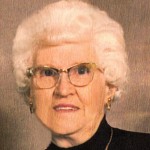
 On July 19, 1989, in the skies over Alta, Iowa, United Airlines Flight 232, on which my great aunt, Gladys Cooper was a passenger, began the fateful journey to a catastrophic end. At 3:16pm, the rear engine’s fan disk broke apart due to a previously undetected metallurgical defect located in a critical area of the titanium-alloy. Basically that meant that the fan disk shattered, sending shrapnel through the hydraulic lines of all three independent hydraulic systems on board the aircraft. This horrific event caused the rapid loss of all the hydraulic fluid. The subsequent catastrophic disintegration of the disk had resulted in a spray of debris with energy levels that exceeded the level of protection provided by design features of the hydraulic systems that operate the DC-10’s flight controls. The flight crew lost its ability to operate nearly all of them. In the resulting crash landing, the right wing just tapped the runway, causing the plane to cartwheel and break apart as it went careening down the runway and into a corn field. While my Great Aunt Gladys was killed in the crash, the skill of the pilot and flight crew saved 185 lives, including their own.
On July 19, 1989, in the skies over Alta, Iowa, United Airlines Flight 232, on which my great aunt, Gladys Cooper was a passenger, began the fateful journey to a catastrophic end. At 3:16pm, the rear engine’s fan disk broke apart due to a previously undetected metallurgical defect located in a critical area of the titanium-alloy. Basically that meant that the fan disk shattered, sending shrapnel through the hydraulic lines of all three independent hydraulic systems on board the aircraft. This horrific event caused the rapid loss of all the hydraulic fluid. The subsequent catastrophic disintegration of the disk had resulted in a spray of debris with energy levels that exceeded the level of protection provided by design features of the hydraulic systems that operate the DC-10’s flight controls. The flight crew lost its ability to operate nearly all of them. In the resulting crash landing, the right wing just tapped the runway, causing the plane to cartwheel and break apart as it went careening down the runway and into a corn field. While my Great Aunt Gladys was killed in the crash, the skill of the pilot and flight crew saved 185 lives, including their own.
While listening to an audio book about World War II, and what happens when bombers flew through flak (Fl(ieger)a(bwehr)k(anone)). I knew that on at least one occasion, my dad, Allen Spencer, a Flight Engineer and Top Turret Gunner on a B-17 in World War II, was tasked with the job of cranking down the landing gear for landing. I don’t know what I had been thinking happened to the landing gear, maybe a close bit of flak the bent something in the gear perhaps, but what had not occurred to me was a catastrophic hit of that flak, causing all hydraulics to be lost. Nevertheless, quite likely that is what happened. It was one of the scenarios discussed in the book. As the hydraulics were lost, the red fluid was all over the floor of the aircraft, and the next thing that was required was to crank down the landing gear, because the gear could not be lowered without hydraulic fluid. Somehow, Dad’s precarious position of hanging out in the open bomb bay doors seemed like such a simple solution to the problem, albeit a heroic act, but the loss of hydraulics could have meant death to the crew. Getting the landing gear down was only part of the problem. What about the flaps, brakes, and such. These planes were in a really bad way.
Of course, my dad’s plane did land safely, given that he became my dad, but years later, when my mother, Collene Spencer’s Aunt Gladys was on a plane crippled by the loss of all hydraulics, I now realize…finally, that when my dad heard about what happened with Flight 232, as we all eventually did, he understood full well, 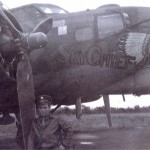
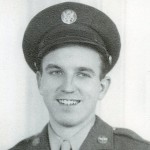 what the flight crew had been faced with. Something I only understood from the view of a spectator…for lack of a better word. He had been there. The Flight 232 situation quite likely took my dad back some 45 years to that day when he had to crank down the landing gear on a B-17 Bomber that had been damaged by flak, probably spilling hydraulic fluid all over the floor where the crew was standing. The experience must have been awful to go through, and the thought of what happened to Flight 232, almost as bad. And yet, in typical World War II veteran style, Dad said nothing, but rather set about comforting his family over the loss.
what the flight crew had been faced with. Something I only understood from the view of a spectator…for lack of a better word. He had been there. The Flight 232 situation quite likely took my dad back some 45 years to that day when he had to crank down the landing gear on a B-17 Bomber that had been damaged by flak, probably spilling hydraulic fluid all over the floor where the crew was standing. The experience must have been awful to go through, and the thought of what happened to Flight 232, almost as bad. And yet, in typical World War II veteran style, Dad said nothing, but rather set about comforting his family over the loss.

 Yesterday, while watching television, one of the shows I like to watch…Why Planes Crash…came on. This particular episode included the cause of Flight 232 in Sioux City, Iowa. This particular crash had an enormous impact on my own life, and that of my mother’s family. It was the one in which my Great Aunt Gladys Pattan Byer Cooper was killed. I have watched the footage numerous times, as well as the episode of Why Planes Crash that contained the answer, but it seems that each time, I learn something new about the crash. I’m not sure why some of the information didn’t stick in my head the first time it was aired, because it most certainly was information that was pointed out. Nevertheless, it didn’t stick in my head that first time or even the subsequent times…until now.
Yesterday, while watching television, one of the shows I like to watch…Why Planes Crash…came on. This particular episode included the cause of Flight 232 in Sioux City, Iowa. This particular crash had an enormous impact on my own life, and that of my mother’s family. It was the one in which my Great Aunt Gladys Pattan Byer Cooper was killed. I have watched the footage numerous times, as well as the episode of Why Planes Crash that contained the answer, but it seems that each time, I learn something new about the crash. I’m not sure why some of the information didn’t stick in my head the first time it was aired, because it most certainly was information that was pointed out. Nevertheless, it didn’t stick in my head that first time or even the subsequent times…until now.
I have often wondered why it takes so long to find the cause of some of the plane crashes…especially the ones where there were survivors and where the black box was so easily found, but sometimes it just does take time. One of the possibilities is that some of the tiny parts, or even large parts of the plane seem to be missing. That was the case with Flight 232. The entire fan disk of its tail mounted General Electric CF6-6 engine failed and disintegrated. I’m sure that the investigators knew that something happened to the fan disk, but without it,  they could not say what happened. The initial explosion that was heard was over Alta, Iowa…about 60 miles from their final crash site in Sioux City, Iowa. This was the point when the fan disk disintegrated. Now, 60 miles may not seem like such a large distance, but add to that the fact that the plane circled around trying to burn up it’s fuel, and trying to stay upright, and the fact that when the fan disk disintegrated, it was traveling at a tremendous amount of speed. In the end, the fan disk was discovered quite by accident three months later, on October 10, 1989, when Janice Sorenson, a farmer harvesting corn near Alta, Iowa, felt resistance on her combine, and after getting out to investigate, discovered most of the fan disk with a number of blades still attached partially buried in her cornfield. The rest of the fan disk and most of the additional blades were located later in the harvest. That would be the point that the investigation could finally bring to a conclusion the actual cause of the crash that had taken my great aunt’s life.
they could not say what happened. The initial explosion that was heard was over Alta, Iowa…about 60 miles from their final crash site in Sioux City, Iowa. This was the point when the fan disk disintegrated. Now, 60 miles may not seem like such a large distance, but add to that the fact that the plane circled around trying to burn up it’s fuel, and trying to stay upright, and the fact that when the fan disk disintegrated, it was traveling at a tremendous amount of speed. In the end, the fan disk was discovered quite by accident three months later, on October 10, 1989, when Janice Sorenson, a farmer harvesting corn near Alta, Iowa, felt resistance on her combine, and after getting out to investigate, discovered most of the fan disk with a number of blades still attached partially buried in her cornfield. The rest of the fan disk and most of the additional blades were located later in the harvest. That would be the point that the investigation could finally bring to a conclusion the actual cause of the crash that had taken my great aunt’s life.
That event has always been a little fuzzy for me. Not the crash, or even the loss of Aunt Gladys, but the whole investigation. For years I’m not sure I really wrapped my mind around the cause of the crash…at least not until I saw the animated reenactment of the crash. Then it became crystal clear what had happened. The breaking 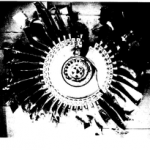
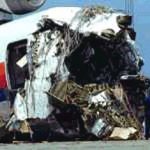 up of the fan disk, caused by a crack that happened when the disk was made, due to impurities in the Titanium, brought down the plane. The crew, including a flight instructor who happened to be onboard, did an amazing job in their efforts not to crash. In the end, it would be on slight dip of the wind caused by a failed hydraulic system that would cause it to tap the ground and cartwheel the plane. It was the event that would forever change our family, from one who had never had someone killed in an airplane crash, to one the had. We would never forget it, and we deeply miss Aunt Gladys to this day.
up of the fan disk, caused by a crack that happened when the disk was made, due to impurities in the Titanium, brought down the plane. The crew, including a flight instructor who happened to be onboard, did an amazing job in their efforts not to crash. In the end, it would be on slight dip of the wind caused by a failed hydraulic system that would cause it to tap the ground and cartwheel the plane. It was the event that would forever change our family, from one who had never had someone killed in an airplane crash, to one the had. We would never forget it, and we deeply miss Aunt Gladys to this day.
 As a writer, I don’t usually have very much time for reading. Yesterday, however, on a long drive with my mom and sister, Cheryl, heading to Wisconsin to visit our family out there, I found myself with a few minutes to read. Since being in contact with Jerry Schemmel, who is a survivor and hero of the United Flight 232 crash in Sioux City, Iowa, I have been thinking a lot about the plane crash that took my Great Aunt Gladys’ life. Jerry wrote a book about his experience, and I have purchased that, but while waiting for that book, I had started another book about that flight, and the miracle that it really was. There is much that we really had no idea about when that crash took place 25 years ago July 19th. For one thing, the DC-10 should not be able to fly…at all…with the hydraulics gone, and yet that crew managed to keep that plane in the air for an astonishing 45 minutes after losing the number two engine and all of their hydraulics.
As a writer, I don’t usually have very much time for reading. Yesterday, however, on a long drive with my mom and sister, Cheryl, heading to Wisconsin to visit our family out there, I found myself with a few minutes to read. Since being in contact with Jerry Schemmel, who is a survivor and hero of the United Flight 232 crash in Sioux City, Iowa, I have been thinking a lot about the plane crash that took my Great Aunt Gladys’ life. Jerry wrote a book about his experience, and I have purchased that, but while waiting for that book, I had started another book about that flight, and the miracle that it really was. There is much that we really had no idea about when that crash took place 25 years ago July 19th. For one thing, the DC-10 should not be able to fly…at all…with the hydraulics gone, and yet that crew managed to keep that plane in the air for an astonishing 45 minutes after losing the number two engine and all of their hydraulics.
That situation…total loss of hydraulics should have immediately thrown the plane into a rollover situation…meaning that it should have rolled onto its back. The events that would have followed should have been a fast spiral downward, causing the wings and tail to break off of the plane. The plane should have then gone barreling into the ground like a rocket, resulting in the instant death of all persons on board. The fact that none of the things that should have happened…did happen, caused all those who were trying to help the plane to assume that the pilots has misdiagnosed the problem that the plane had. Some even assumed that they could land in Chicago, Illinois, instead of Sioux City, Iowa. I’m sure that to the crew, this all seemed incredible. The people helping them should have known that they knew how to  read their instruments, and they did, but what they were saying was impossible…totally impossible. Nevertheless, it was happening, and the pilots were flying it…against all odds…against the impossible. They even called the people at United Airlines Systems Aircraft Maintenance, also known as SAM to see if they could help. They thought the pilots had misdiagnosed the problem too, until they confirmed that the hydraulic fluid had all leaked out. The people at SAM said later that they had no idea what to say to the crew, because they felt like they were talking to four dead men. They didn’t believe anyone could survive it.
read their instruments, and they did, but what they were saying was impossible…totally impossible. Nevertheless, it was happening, and the pilots were flying it…against all odds…against the impossible. They even called the people at United Airlines Systems Aircraft Maintenance, also known as SAM to see if they could help. They thought the pilots had misdiagnosed the problem too, until they confirmed that the hydraulic fluid had all leaked out. The people at SAM said later that they had no idea what to say to the crew, because they felt like they were talking to four dead men. They didn’t believe anyone could survive it.
There was no procedure for a full loss of hydraulics. Flight simulators didn’t teach that scenario, because it was not considered survivable. It had never happened…and if it had, no one survived, because this was not a survivable event…at least it wasn’t until that day. This pilot and co-pilot were flying by the seat of their pants, and the normal fixes wouldn’t work. Captain Al Haynes simply moved on instinct when he used the throttles. He thought he had seen something in the manual about it, but I’m not sure it was there, because it was not supposed work. He was basically using power to control the plane. The plane wanted to turn over, and so, using asymmetric thrust, he was able to keep it making wide loops, and finally ended up at the airport. It would also take the help of a fourth person to make this work. Thankfully they had DC-10 instructor, Dennis Fitch on board to handle the extra need. Each loop caused them to lose altitude, and so at one point they didn’t think they would make the airport. In the end, they had to use a runway that had not been used or maintained in a year. That did not contribute to the crash, however.
I have watched the crash video many times, and you can see that the crew…and I do say the crew, because it took all three of them, and the instructor to run all 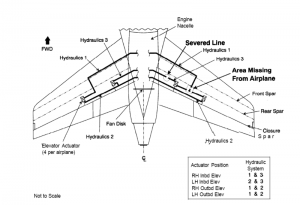 the controls that it took to maneuver the plane…almost landed the plane safely. They were so close. Then the plane tried one more time to roll over, causing the right wing to tap the ground. That was all it took to cartwheel the plane down the runway. In watching that crash, I have no idea how anyone survived it at all…much less more than half of the occupants, including all of the crew. It was a miracle of God, and an answer to the many prayers that were being prayed on board that day. I wish Aunt Gladys had survived, but that was not to be. Nevertheless, there were many heroes that day, and the crew who flew that plane were definitely the greatest.
the controls that it took to maneuver the plane…almost landed the plane safely. They were so close. Then the plane tried one more time to roll over, causing the right wing to tap the ground. That was all it took to cartwheel the plane down the runway. In watching that crash, I have no idea how anyone survived it at all…much less more than half of the occupants, including all of the crew. It was a miracle of God, and an answer to the many prayers that were being prayed on board that day. I wish Aunt Gladys had survived, but that was not to be. Nevertheless, there were many heroes that day, and the crew who flew that plane were definitely the greatest.
 My Great Aunt Gladys, passed away on July 19, 1989. She was a passenger on United Airlines Flight 232, which crashed at Sioux Gateway Airport in Sioux City, Iowa. It was a crash I’m sure many of you will remember. According to the pilot on that flight, Captain Al Haynes a veteran pilot with 30,000 hours of flying time, “When the #2 hydraulics on the DC-10 blew, or when the #2 engine blew, it took out the #2 accessory drive section, which took out the hydraulics for the #2 system. And some 70 pieces of shrapnel penetrated the horizontal stabilizer and severed the #1 line and the #3 line, and as a result we ended up with no hydraulics.”
My Great Aunt Gladys, passed away on July 19, 1989. She was a passenger on United Airlines Flight 232, which crashed at Sioux Gateway Airport in Sioux City, Iowa. It was a crash I’m sure many of you will remember. According to the pilot on that flight, Captain Al Haynes a veteran pilot with 30,000 hours of flying time, “When the #2 hydraulics on the DC-10 blew, or when the #2 engine blew, it took out the #2 accessory drive section, which took out the hydraulics for the #2 system. And some 70 pieces of shrapnel penetrated the horizontal stabilizer and severed the #1 line and the #3 line, and as a result we ended up with no hydraulics.”
It was a situation that had a 1 in 1 billion chance of happening, but on July 19, 1989, on United Airlines Fight 232 which had taken off from Stapleton International Airport in Denver, Colorado, bound for Chicago, Illinois with 296 souls on board, one of which was my Great Aunt Gladys, it did happen. Of the 285 passengers and 11 crew members, 184 people would survive the subsequent crash of United Airlines Flight 232…sadly, my Great Aunt Gladys was not one of them. The airline was having a special that day, in which children flying with a parent flew for half price. That special put an unusually large number of children on the flight…52 to be exact. A number of those kids were traveling alone. Four children were “lap” children…children without a seat of their own. Eleven children, including 1 “lap” child died in the disaster.
The passengers on board the flight knew they were in trouble for 45 minutes before the crash. I have often thought about what my Aunt Gladys was thinking about during those 45 minutes. Her family, of course…hoping she would be able to return home to see them again. Worry and fear must have entered in, and it makes me so sad to think that her last minutes were spent in such a manner. My mom said something to me after we found out that she had not survived, that makes me think that she was thinking of one other thing…the children. Mom said that Aunt Gladys would have wanted the children to survive, because they had not had a chance at life yet. I think that is true, because Aunt Gladys was always so sweet to the children. She never said one harsh word to me or my sisters…even when we wanted to play with her Avon products or touch her silk nylons, because they were so soft.
During the crash, the plane cartwheeled, and possessions where thrown all over the  place. So came about the misinformation that made us believe that Aunt Gladys had survived. Her purse went to the hospital with another woman. Upon further investigation, they would find that it was not my aunt, but not before the news media had listed her as a survivor. It was not their fault, but nevertheless heartbreaking to our family. Today marks the 23rd anniversary of the crash of United Flight 232 in Sioux City, Iowa, and the subsequent loss of my dear Great Aunt Gladys. Sometimes, when I see a woman who resembles her, my heart still jumps, because it’s almost like she is still here. I suppose that happens because we could not view her body, and maybe that isn’t the worst thing. At least we can still imagine her among the living. We love and still miss you Aunt Gladys.
place. So came about the misinformation that made us believe that Aunt Gladys had survived. Her purse went to the hospital with another woman. Upon further investigation, they would find that it was not my aunt, but not before the news media had listed her as a survivor. It was not their fault, but nevertheless heartbreaking to our family. Today marks the 23rd anniversary of the crash of United Flight 232 in Sioux City, Iowa, and the subsequent loss of my dear Great Aunt Gladys. Sometimes, when I see a woman who resembles her, my heart still jumps, because it’s almost like she is still here. I suppose that happens because we could not view her body, and maybe that isn’t the worst thing. At least we can still imagine her among the living. We love and still miss you Aunt Gladys.

